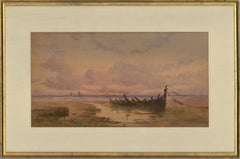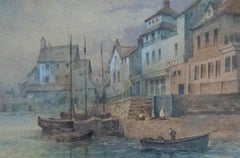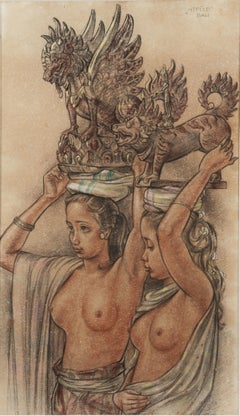Walter William May Art
to
2
1
2
1
1
Overall Height
to
Overall Width
to
2
1
1
1
1
2
2
6,886
3,209
2,514
1,217
2
2
Artist: Walter William May
Walter William May (1831-1896) - Late 19thC Watercolour, Sunset At Low Tide
By Walter William May
Located in Corsham, GB
A striking late 19th Century beach scene showing the silhouette of a wrecked boat on the wet sands at low tide. The artist has signed to the lower r...
Category
Late 19th Century Walter William May Art
Materials
Watercolor
Walter William May (1831-1896) - Late 19thC Watercolour, Overcast Harbour Town
By Walter William May
Located in Corsham, GB
A fine watercolour showing a coastal harbour town under a grey sky. The artist has wonderfully captured the flat light of a grey day at the coast. Figures can be seen at the dockside...
Category
19th Century Walter William May Art
Materials
Watercolor
Related Items
Two Seated Men
By Henri Lebasque
Located in New York, NY
“Two Seated Men” by Henri Lebasque (1865-1937)
Pencil and watercolor on paper
6 x 5 inches unframed (15.24 x 12.7 cm)
Signed on bottom right
Description:
In ...
Category
20th Century Walter William May Art
Materials
Watercolor, Pencil
Two Balinese Beauties (Mapeed), circa 1945
By Johan Rudolf Bonnet
Located in Amsterdam, NL
Rudolf Bonnet (1895-1978)
'Mepèèd' (Mapeed)
Signed lower right
Titled upper right
Pastel on gouache pigmented paper, 57 x 34 cm
In original carved ebo...
Category
1940s Walter William May Art
Materials
Paper, Crayon, Pastel, Gouache, Pencil
Free Shipping
H 22.45 in W 13.39 in D 0.04 in
The Abduction of the Sabine Women , a Renaissance drawing by Biagio Pupini
Located in PARIS, FR
This vigorous drawing has long been attributed to Polidoro da Caravaggio: The Abduction of the Sabine Women is one of the scenes that Polidoro depicted between 1525 and 1527 on the façade of the Milesi Palazzo in Rome. However, the proximity to another drawing inspired by this same façade, kept at the Ecole des Beaux-Arts, and to other drawings inspired by Polidoro kept at the Musée du Louvre, leads us to propose an attribution to Biagio Pupini, a Bolognese artist whose life remains barely known, despite the abundant number of drawings attributed to him.
1. Biagio Pupini, a Bolognese artist in the light of the Roman Renaissance
The early life of Biagio Pupini, an important figure of the first half of the Cinquecento in Bologna - Vasari mentions him several times - is still poorly known. Neither his date of birth (probably around 1490-1495) nor his training are known. He is said to have been a pupil of Francesco Francia (1450 - 1517) and his name appears for the first time in 1511 in a contract with the painter Bagnacavallo (c. 1484 - 1542) for the frescoes of a church in Faenza. He then collaborated with Girolamo da Carpi, at San Michele in Bosco and at the villa of Belriguardo.
He must have gone to Rome for the first time with Bagnacavallo between 1511 and 1519. There he discovered the art of Raphael, with whom he might have worked, and that of Polidoro da Caravaggio. This first visit, and those that followed, were the occasion for an intense study of ancient and modern art, as illustrated by his abundant graphic production.
Polidoro da Caravaggio had a particular influence on the technique adopted by Pupini. Executed on coloured paper, his drawings generally combine pen, brown ink and wash with abundant highlights of white gouache, as in the drawing presented here.
2. The Abduction of the Sabine Women
Our drawing is an adaptation of a fresco painted between 1525 and 1527 by Polidoro da Caravaggio on the façade of the Milesi Palace in Rome. These painted façades were very famous from the moment they were painted and inspired many artists during their stay in Rome. These frescoes are now very deteriorated and difficult to see, as the palace is in a rather narrow street.
The episode of the abduction of the Sabine women (which appears in the centre of the photo above) is a historical theme that goes back to the origins of Rome and is recounted both by Titus Livius (Ab Urbe condita I,13), by Ovid (Fasti III, 199-228) and by Plutarch (II, Romulus 14-19). After killing his twin brother Romus, Romulus populates the city of Rome by opening it up to refugees and brigands and finds himself with an excess of men. Because of their reputation, none of the inhabitants of the neighbouring cities want to give them their daughters in marriage. The Romans then decide to invite their Sabine neighbours to a great feast during which they slaughter the Sabines and kidnap their daughters.
The engraving made by Giovanni Battista Gallestruzzi (1618 - 1677) around 1656-1658 gives us a good understanding of the Polidoro fresco, allowing us to see how Biagio Pupini reworked the scene to extract this dynamic group.
With a remarkable economy of means, Biagio Pupini takes over the left-hand side of the fresco and depicts in a very dense space two main groups, each consisting of a Roman and a Sabine, completed by a group of three soldiers in the background (which seems to differ quite significantly from Polidoro's composition).
The balance of the drawing is based on a very strongly structured composition. The drawing is organised around a median vertical axis, which runs along both the elbow of the kidnapped Sabine on the left and the foot of her captor, and the two main diagonals, reinforced by four secondary diagonals. This diamond-shaped structure creates an extremely dynamic space, in which centripetal movements (the legs of the Sabine on the right, the arm of the soldier on the back at the top right) and centrifugal movements (the arm of the kidnapper on the left and the legs of the Sabine he is carrying away, the arm of the Sabine on the right) oppose each other, giving the drawing the appearance of a whirlpool around a central point of support situated slightly to the left of the navel of the kidnapper on the right.
3. Polidoro da Caravaggio, and the decorations of Roman palaces
Polidoro da Caravaggio was a paradoxical artist who entered Raphael's (1483 - 1520) workshop at a very young age, when he oversaw the Lodges in the Vatican. Most of his Roman work, which was the peak of his career, has disappeared, as he specialised in facade painting, and yet these paintings, which are eminently visible in urban spaces, have influenced generations of artists who copied them abundantly during their visits to Rome.
Polidoro Caldara was born in Caravaggio around 1495-1500 (the birthplace of Michelangelo Merisi, known as Caravaggio, who was born there in 1571), some forty kilometres east of Milan. According to Vasari, he arrived as a mason on the Vatican's construction site and joined Raphael's workshop around 1517 (at the age of eighteen according to Vasari). This integration would have allowed Polidoro to work not only on the frescoes of the Lodges, but also on some of the frescoes of the Chambers, as well as on the flat of Cardinal Bibiena in the Vatican.
After Raphael's death in 1520, Polidoro worked first with Perin del Vaga before joining forces with Maturino of Florence (1490 - 1528), whom he had also known in Raphael's workshop. Together they specialised in the painting of palace façades. They were to produce some forty façades decorated with grisaille paintings imitating antique bas-reliefs.
The Sack of Rome in 1527, during which his friend Maturino was killed, led Polidoro to flee first to Naples (where he had already stayed in 1523), then to Messina. It was while he was preparing his return to the peninsula that he was murdered by one of his assistants, Tonno Calabrese, in 1543.
In his Vite, Vasari celebrated Polidoro as the greatest façade decorator of his time, noting that "there is no flat, palace, garden or villa in Rome that does not contain a work by Polidoro". Polidoro's facade decorations, most of which have disappeared as they were displayed in the open air, constitute the most important lost chapter of Roman art of the Cinquecento. The few surviving drawings of the painter can, however, give an idea of the original appearance of his murals and show that he was an artist of remarkable and highly original genius.
4. The façade of the Milesi Palace
Giovanni Antonio Milesi, who commissioned this palace, located not far from the Tiber, north of Piazza Navona, was a native of the Bergamo area, like Polidoro, with whom he maintained close friendly ties. Executed in the last years before the Sack of Rome, around 1526-1527, the decoration of Palazzo Milesi is considered Polidoro's greatest decorative success.
An engraving by Ernesto Maccari made at the end of the nineteenth century allows us to understand the general balance of this façade, which was still well preserved at the time. The frescoes were not entirely monochrome, but alternated elements in chiaroscuro simulating marble bas-reliefs and those in ochre simulating bronze and gold vases...
Category
16th Century Old Masters Walter William May Art
Materials
Ink, Gouache, Pen
Gustav Melcher ( German, 1898 -?) Boats off Venice Italy Ink Water Color c. 1918
By Gustav Melcher
Located in Meinisberg, CH
Gustav Melcher
(German, 1898-?)
Segelschiffe vor Venedig - Sailing ships off Venice
• India ink, water colour wash
• Visible image ca. 11.5 x 18 cm
• Glased Frame ca. 20 x 25 cm
• Verso various inscriptions
• Signed lower right
Gustav Melcher was a German painter and a pioneer in film, film criticism and film theory and created this clever little picture of the skyline of Venice with various vessels.
Going by the various inscriptions an the backing paper, this drawing was made in 1918 when Gustav was twenty years old and passed on three years later to Gertrud Melcher on the 1. 2. 1921. I have no reasons to doubt this information. The small drawing is still in its unopened frame, so maybe there is more information to be discovered , however this will be the privilege of the next owner.
The picture also has retained its original antique frame – note that it has lost over the years various sections of the gesso decoration.
The very precisely executed drawing is most enjoyable to look at and doing so, remember you are looking through the eyes of a young man, who saw this foreign sea cape over a century ago.
Thank you for your interest and please note, that I offer free worldwide shipping on all my items.
Gustav Melcher began his studies at the Düsseldorfer Kunstakademie under Peter Janssen and Eduard von Gebhardt. Originaly he was interested in figurative and portrait painting, but after time he decided to pursue the depiction of land- and marinescapes. Durin his studies the young artist undertook trips to visit England, Scotland, Belgium and France and he joined the artist society Malkasten. It was in those days he would hold speeches to his colleges about this new invention called ‘Kintopp’ – Melcher was a great advocate of the moving pictures...
Category
1910s Naturalistic Walter William May Art
Materials
India Ink, Paper, Watercolor
Gustav MelcherGustav Melcher ( German, 1898 -?) Boats off Venice Italy Ink Water Color c. 1918, 1918
Free Shipping
H 7.88 in W 9.85 in D 0.79 in
Window onto the Sea, Original Drawing, Contemporary Landscape, Architecture
Located in AIX-EN-PROVENCE, FR
Work : Original Drawing, Handmade Artwork, Unique Work. The work has been treated with UV-resistant varnish and it is not framed.
Medium : Watercolour, Soft Pastel and Oil based col...
Category
21st Century and Contemporary Impressionist Walter William May Art
Materials
Archival Paper, Color Pencil, Pastel, Watercolor
H 11.82 in W 11.82 in D 0.12 in
Study after Michelangelo’s “The Last Judgment”
By Michelangelo Buonarroti
Located in New York, NY
Italian School, 16th Century
Provenance:
Private Collection, New York
This intriguing drawing is a study by an anonymous 16th-century Italian artist after a vignette in Michelangelo’s fresco of The Last Judgement in the Sistine Chapel. The altar wall of the Sistine Chapel was already richly decorated when Pope Clement VII commissioned Michelangelo to paint his Last Judgment...
Category
16th Century Old Masters Walter William May Art
Materials
Paper, Gouache
The Argument
Located in New York, NY
Signed and inscribed on a label on the verso:
No. 1/ The Argument/ W. Cave Thomas/ 203 Camden Rd/ NW
Provenance:
Christie’s, London, 6 November 1995, lot 88.
Private Collection, London.
This powerful watercolor is a mature work by the little-known Victorian painter William Cave Thomas...
Category
19th Century Pre-Raphaelite Walter William May Art
Materials
Paper, Watercolor, Pencil
Rudolf Johann Weiss (1846-1933) - Gateway of Ptolemy III Thebes Egypt 19thC W/C
By Rudolf Johann Weiss
Located in Meinisberg, CH
Rudolf Johann Weiss
(Swiss, * 3.9.1846 Basel; † 17.4.1933 Biel/Bienne, Switzerland)
Ancient Gateway of Ptolemy III by Thebes in Egypt
• 19th century water colour on paper, visible ...
Category
1870s Victorian Walter William May Art
Materials
Paper, Watercolor
Free Shipping
H 11.03 in W 14.57 in D 0.79 in
Moses With the Ten Commandments
By Sir Jacob Epstein
Located in New York, NY
Moses With the Ten Commandments by Sir Jacob Epstein (1880-1959)
Pencil and watercolor on paper
22 x 16 ⅝ inches unframed (55.88 x 42.24 cm)
28 ½ x 23 inches framed (72.39 x 58.42 cm)
Signed on bottom left
Description:
In this figurative watercolor painting, Jacob Epstein depicts Moses holding two tablets, one in each arm, that are inscribed with the ten commandments. This is a visualization of the traditional biblical story in which Moses goes to Mount Sinai and has the ten commandments revealed to him by God which he inscribed onto two tablets and keeps in the Ark of the Covenant...
Category
20th Century Post-Modern Walter William May Art
Materials
Watercolor, Pencil
Richard Caton Woodville II (1856 - 1927) 1794 War Balloon Aquarell England 1910
By Richard Caton Woodville Jr.
Located in Meinisberg, CH
Richard Caton Woodville II
(British, 1856 - 1927)
The French Aerostatic Corps - The first War Balloon The launching of the L'Entreprenant used by the French Army under General Jourd...
Category
1910s English School Walter William May Art
Materials
Paper, Watercolor, Gouache, Cardboard
Free Shipping
H 15.56 in W 22.25 in D 1.58 in
19th century watercolour of a Girl at her Dressing Table
By William Henry Hunt
Located in London, GB
Collections:
Muir Hetherington;
Sir John and Lady Witt, acquired 1974;
By descent to 2015.
Literature:
Tom Jones (ed.), William Henry Hunt 1790-1864, exh. cat., 1981, no. 145 (Girl in a bedroom);
John Witt, William Henry Hunt (1790-1864) Life and Work, London, 1982, no. 553, p. 194, colour pl. 16.
Exhibited:
Wolverhampton, Central Art Gallery, Preston, Harris Museum and Art Gallery and Hastings, Hastings Museum and Art Gallery, William Henry Hunt 1790-1864, 1981, no. 145 as Girl in a bedroom (Lent by Sir John & Lady Witt)
Framed dimensions: 20 x 20.75 inches
This unusually charming and well-preserved watercolour was painted by William Henry Hunt in around 1833. Almost certainly depicting his young wife, Sarah, possibly in the interior of her family home at Bramley in Hampshire. This work shows Hunt’s remarkable virtuosity as a watercolourist, Hunt, for example, articulates the profile of his young wife, by leaving a reserve of white paper to suggest the light modelling her features. Throughout the 1830s Hunt made a sequence of richly painted interior views of both domestic and agricultural spaces which pay scrupulous attention to detail.
Hunt was born in London, the son of a tin-plate worker and japanner. J. L. Roget recorded the observation of Hunt’s uncle: ‘nervy, little Billy Hunt… was always a poor cripple, and as he was fit for nothing, they made an artist of him.’ At the age of sixteen he was apprenticed to the landscape painter John Varley for seven years, moving to live with Varley at 18 Broad Street, Golden Square, London. There he made close friends with both John Linnell and William Mulready. Hunt worked at the ‘Monro Academy’, at 8 Adelphi Terrace, London, the house of Dr Thomas Monro, an enthusiastic patron of landscape watercolourists. Through Monro, Hunt was introduced to the 5th Earl of Essex...
Category
19th Century Old Masters Walter William May Art
Materials
Watercolor, Pencil
untitled / ohne Titel
By Martin Eder
Located in New York, NY
Martin Eder untitled work on paper executed in ballpoint pen with traces of watercolor. Ohne Titel Arbeit auf Papier, ausgeführt in Kugelschreiber mit Spuren von Aquarell. 2007
Category
Early 2000s Realist Walter William May Art
Materials
Ink, Watercolor, Pen
Previously Available Items
Walter William May - Signed 19th Century Scottish Watercolour Highland Landscape
By Walter William May
Located in Corsham, GB
A beautiful 19th Century watercolour depicting a highland landscape, with a meandering river leading to a loch and highland cattle grazing on heather. Excellently presented in a peri...
Category
19th Century Victorian Walter William May Art
Materials
Watercolor
Walter William May art for sale on 1stDibs.
Find a wide variety of authentic Walter William May art available for sale on 1stDibs. You can also browse by medium to find art by Walter William May in paint, watercolor and more. Not every interior allows for large Walter William May art, so small editions measuring 13 inches across are available. Customers who are interested in this artist might also find the work of Reginald Hallward, Harold Hope Read, David Jones, CH, and CBE. Walter William May art prices can differ depending upon medium, time period and other attributes. On 1stDibs, the price for these items starts at $464 and tops out at $470, while the average work can sell for $467.
Artists Similar to Walter William May
Robert Sargent Austin, R.A., P.R.E., P.R.W.S.




